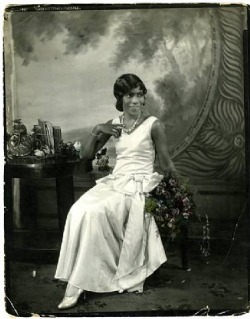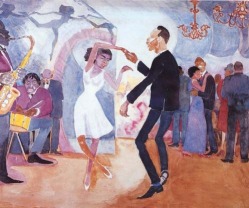There is something very unique about the paintings from the Harlem Renaissance. Despite the situation they were in, most of their artwork seemed to resemble something different. They seemed to be pictures of a happy time where they were surrounded by loved ones and didn't have a care in the world. Whether this was created out of their imaginations of what was to come when racism ended or if it was what it truly was like in Harlem during this time it lifted people's hopes and excited them for the reaching of their dreams, which they hoped was in the near future.
Aaron Douglas (1899-1979)

Aaron Douglas was a widespread artist deeply involved in the Harlem Renaissance and the movement to abolish Slavery. Douglas was a strong believer in African American pride and encouraged colored people all over never to let racism get to their hearts and always to rise above and do great things. Douglas created pictures on the cover of books that portrayed all that African Americans had come through to get this far. I believe that in creating images like this he wanted the African American population to know that there was hope and in order to get the life they dreamed of they had to hold onto that and keep pushing for more and more rights. Aaron Douglas was an inspiration to artists and African Americans as a whole.
James Vanderzee (1886-1983)

African Americans originally came to Harlem looking for a place that they could not only fit in, but become successful at whatever it was they wanted to do. However, not everyone that came to Harlem knew what they wanted to do or who they wanted to be. James Vanderzee was one of these people. He started out as a musician and only practiced the art of photography in his spare time as a hobby. However he soon realized that photography was really the only thing he wanted to do for the rest of his life and from then onward brought about enjoyment and happiness with his amazing photo’s.
Palmer Hayden (1890-1973)

Palmer Hayden was a well known painter in the Harlem Renaissance. He used both oil and watercolor and most often portrayed landscapes and pictures of society in his paintings and sketches. There was some controversy attached to his work, though. He often exaggerated the features of African Americans in his work and that caused an upset among viewers for quite some time. Whether he did this to encourage African Americans to take pride in who they were or simply because that is how he saw them it is unknown but he is still remembered to day as one of Harlem’s legendary artists.
Selma Burke (1900-1995)

Imagine a little girl outside of her parents farmhouse surrounded by wet clay. The year is 1907 and the little girl is alone with nothing to do. So she traces her hands through the clay, scoops up a ball of it and begins to compress it, mold it into a shape. That was Selma Burke’s first taste of sculpting, and after that, she fell in love. She continued in school as a nurse, but with all of her spare time she would sculpt, most often of famous people or of nudes. It was her love, her passion and she continued to follow her love of sculpting for the rest of her life, inspiring many generations of future artists.
Augusta Savage (1892-1962)

Augusta Savage knew from childhood that she was destined to create, and to sculpt. Her dream began to from when she was excepted into Cooper Union’s School of Art in the early 1920’s and proceeded to study there as a sculptor. It was immediately clear that this was where she belonged and what she should do for the rest of her life- her talent earned her the privilege of a commission to create a marble bust of W.E.B. Dubois. She later carved many historical figures from Harlem but perhaps her m ost famous piece was a marble bust of her nephew entitled Gamin. She later became a teacher to future generations of artists in Harlem as well as an inspiration to African Americans internationally.










